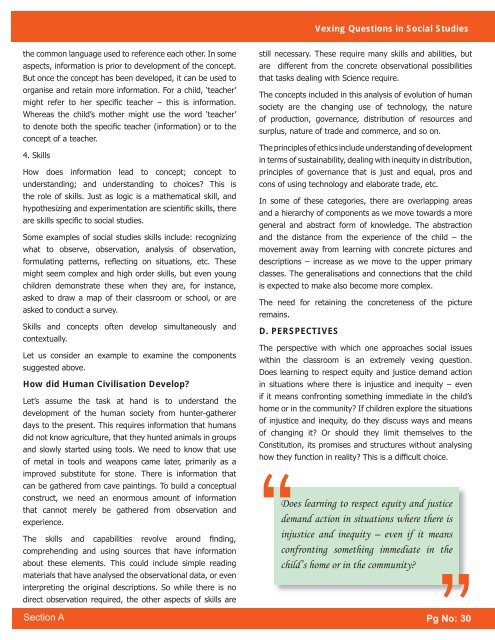Indesign Pagesnew.indd - Azim Premji Foundation
Indesign Pagesnew.indd - Azim Premji Foundation
Indesign Pagesnew.indd - Azim Premji Foundation
You also want an ePaper? Increase the reach of your titles
YUMPU automatically turns print PDFs into web optimized ePapers that Google loves.
the common language used to reference each other. In some<br />
aspects, information is prior to development of the concept.<br />
But once the concept has been developed, it can be used to<br />
organise and retain more information. For a child, ‘teacher’<br />
might refer to her specifi c teacher – this is information.<br />
Whereas the child’s mother might use the word ‘teacher’<br />
to denote both the specifi c teacher (information) or to the<br />
concept of a teacher.<br />
4. Skills<br />
How does information lead to concept; concept to<br />
understanding; and understanding to choices? This is<br />
the role of skills. Just as logic is a mathematical skill, and<br />
hypothesizing and experimentation are scientifi c skills, there<br />
are skills specifi c to social studies.<br />
Some examples of social studies skills include: recognizing<br />
what to observe, observation, analysis of observation,<br />
formulating patterns, refl ecting on situations, etc. These<br />
might seem complex and high order skills, but even young<br />
children demonstrate these when they are, for instance,<br />
asked to draw a map of their classroom or school, or are<br />
asked to conduct a survey.<br />
Skills and concepts often develop simultaneously and<br />
contextually.<br />
Let us consider an example to examine the components<br />
suggested above.<br />
How did Human Civilisation Develop?<br />
Let’s assume the task at hand is to understand the<br />
development of the human society from hunter-gatherer<br />
days to the present. This requires information that humans<br />
did not know agriculture, that they hunted animals in groups<br />
and slowly started using tools. We need to know that use<br />
of metal in tools and weapons came later, primarily as a<br />
improved substitute for stone. There is information that<br />
can be gathered from cave paintings. To build a conceptual<br />
construct, we need an enormous amount of information<br />
that cannot merely be gathered from observation and<br />
experience.<br />
The skills and capabilities revolve around fi nding,<br />
comprehending and using sources that have information<br />
about these elements. This could include simple reading<br />
materials that have analysed the observational data, or even<br />
interpreting the original descriptions. So while there is no<br />
direct observation required, the other aspects of skills are<br />
Section A<br />
still necessary. These require many skills and abilities, but<br />
are different from the concrete observational possibilities<br />
that tasks dealing with Science require.<br />
The concepts included in this analysis of evolution of human<br />
society are the changing use of technology, the nature<br />
of production, governance, distribution of resources and<br />
surplus, nature of trade and commerce, and so on.<br />
The principles of ethics include understanding of development<br />
in terms of sustainability, dealing with inequity in distribution,<br />
principles of governance that is just and equal, pros and<br />
cons of using technology and elaborate trade, etc.<br />
In some of these categories, there are overlapping areas<br />
and a hierarchy of components as we move towards a more<br />
general and abstract form of knowledge. The abstraction<br />
and the distance from the experience of the child – the<br />
movement away from learning with concrete pictures and<br />
descriptions – increase as we move to the upper primary<br />
classes. The generalisations and connections that the child<br />
is expected to make also become more complex.<br />
The need for retaining the concreteness of the picture<br />
remains.<br />
D. PERSPECTIVES<br />
Vexing Questions in Social Studies<br />
The perspective with which one approaches social issues<br />
within the classroom is an extremely vexing question.<br />
Does learning to respect equity and justice demand action<br />
in situations where there is injustice and inequity – even<br />
if it means confronting something immediate in the child’s<br />
home or in the community? If children explore the situations<br />
of injustice and inequity, do they discuss ways and means<br />
of changing it? Or should they limit themselves to the<br />
Constitution, its promises and structures without analysing<br />
how they function in reality? This is a diffi cult choice.<br />
Does learning to respect equity and justice<br />
demand action in situations where there is<br />
injustice and inequity – even if it means<br />
confronting something immediate in the<br />
child’s home or in the community?<br />
Pg No: 30

















